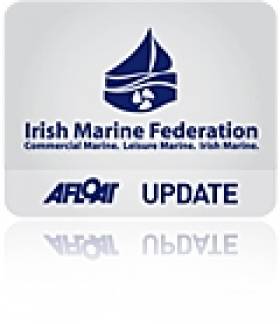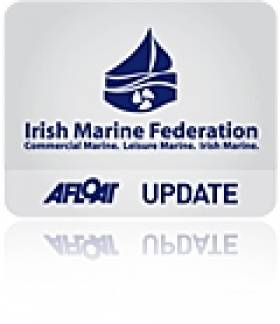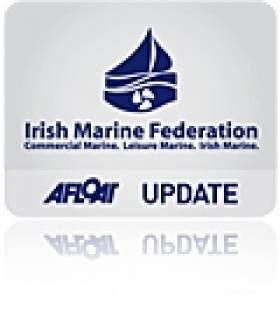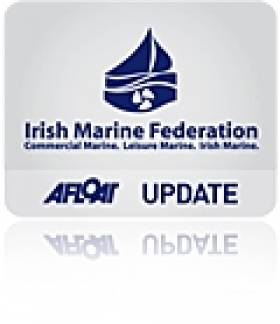Displaying items by tag: Irish Marine Federation
Irish Marine Federation Makes Marine Spatial Plan Submission
The Chairman of the Irish Marine Federation (IMF) has said barriers to investment and sustainability around the Irish coastline have for 'too long stymied growth in the marine sphere'. Paal Janson, who became chairman of the trade body last month, made the remarks as the IMF presented its submission on Marine Spatial Planning framework.
As Afloat.ie previously reported, the proposed new legislation is one of the most significant pieces of national maritime law for several decades. The new regulations will deal with when and where human activities can take place at sea and ensure these activities are as efficient and sustainable as possible.
The IMF is the national organisation representing both commercial and leisure sectors of the marine industry in Ireland.
"one of the most significant pieces of national maritime legislation for decades"
The IMF is part of the Government's Advisory Group on Marine Spatial planning and Janson has a seat at the table to ensure that the voice of its members is heard.
As well as many opportunities, the proposed legislation brings a number of possible threats to recreational craft users and it is important that such threats are fully considered.
"Only through a process of continued engagement with all the relevant stakeholders, across all sectors, can we bring about an integrated policy that will be for the mutual benefit of all parties involved," Janson, who is the General Manager of Dun Laoghaire Marina on Dublin Bay, told Afloat.ie
"The significance and importance of Ireland’s coastal infrastructure to promote jobs, investment and economic sustainability should not be underestimated", he added
The steps towards delivering a planning system for the seas around Ireland were set–out by Government in 2017.
Minister for Housing, Planning and Local Government Eoghan Murphy and Minister Damien English published 'Towards a Marine Spatial Plan for Ireland' for the development of Ireland’s first marine spatial plan which ultimately aims to balance the different demands for using the sea including the need to protect the marine environment.
UK Boaters 'Surprised To Learn' of Irish Marina Facilities
There's been a big shout out for the Irish Marine Federation (IMF) stand at this week's London Boat Show from UK boaters who have been 'surprised to learn' of the range of sailing club and marina facilities available around the Irish coastline. But there have also been expressions of thanks from Irish visitors to the International Show at Excel who are delighted to see Ireland showcased as a maritime destination.
According to stand executive Ciara Dowling, the biggest surprise among some UK boaters visiting the stand (F046) has been the map of Ireland showing over 60 marina locations. Many visitors, she says, simply had not known of the existence of many Irish marina, jetty and pontoon locations, a situation the Irish Marina Federation are keen to rectify.
UK boater feed back from the show so far indicates the close proximity of Wales to Dublin and Ireland's attractive berthing rates compared with the current high value of Sterling against the Euro could be a factor to entice UK boaters to cruise Ireland and even moor boats here in the longer term.
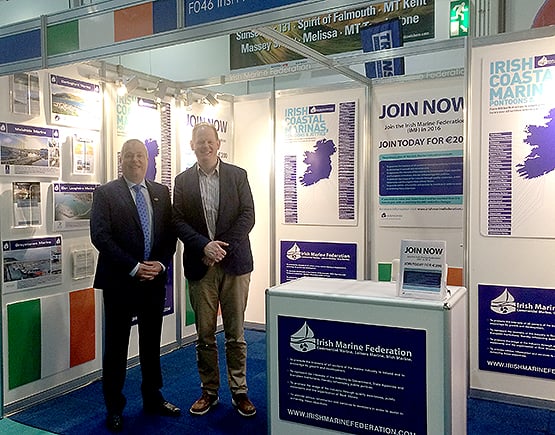
Gerry Salmon of MGM Boats and Paal Janson of Dun Laoghaire on the first ever IMF stand at this week's London Boat Show in Excel.
The Irish Marine Federation (IMF) is promoting a necklace of over 60 Irish coastal marinas and pontoons as a central theme of its London Boat Show promotion that opens at ExCeL in London's Docklands on Friday morning.
As Afloat.ie reported previously, the Irish trade body is supporting the Irish Marina Operators Association (IMOA) who are keen to attract more visiting UK boats to Ireland this Summer. Eight Irish marinas have made the 'voyage' to London to promote their coastal facilties to the estimated 100,000 UK boating enthusiasts that will visit the international show over the next ten days.
Marinas from Eight Irish Counties Represented
Dublin marinas at Dun Laoghaire and Malahide and Cork Harbour Marinas at Royal Cork Yacht Club in Crosshaven along with Greystones marina in Couty Wicklow, Carlingford marina in County Louth and Kilrush Marina in County Clare, Kimore Quay in Wexford and Fenit in County Kerry are among Irish marina representatives manning the Irish stand. 'The aim is to assist UK visitors planning a trip across the Irish sea this Summer to enjoy the full benefits of the Irish coast' says IMF Board Member Gerry Salmon of MGM Boats who has co–ordinated the Irish stand and hopes it will be the start of a regular appearance for Ireland at the International exhibition.
#DunLaoghaire Marina will be there to market our destination to UK marine leisure tourism. https://t.co/45SiExuvqv
— Dun Laoghaire Marina (@DLMarina_Dublin) January 5, 2016
Visit us on the Irish Marine Federation stand at London Boat Show 2016 #LBS16 @eucoolroute https://t.co/KKq9esoP5E pic.twitter.com/JqsMCExLY4
— RCYC (@royalcork) January 8, 2016
Lucy Watson, star of hit Channel 4 series ‘Made in Chelsea’, will open the 62nd annual London Boat Show at 11am oin Friday.
Thousands of boats and brands will be showcased at the event all from leading British and international companies. Exhibitors will range from world-class boat builders through to fashion, travel operators and watersports companies – ensuring there is something for everyone.
Spectacular Show attractions will include a Mediterranean Bay with waterfront cafés and a specially built pool hosting live demonstrations. There will also be hundreds of boats to climb aboard, a 60’s Revival showcasing boating highlights from the era, and themed discussions led by industry experts in the London Boat Show Theatre.
Last March, The Irish Marine Federation (IMF) met in Dublin to address priorities for the marine leisure industry after what has been a torrid time for marine trades in Ireland.
In a notice to members, Federation Chairman David O'Brien said 'like all small businesses, the IMF is building anew after recession'.
In a cautious note of optimism, O'Brien added 'Although it still remains to be seen if we really have 'turned a corner', as our politicians like to tell us, nothing can stay dormant indefinitely.
The IMF, who organises the National Boat Show, expects new opportunities to arise as the economy improves and consumer confidence grows.
Salmon also hopes to recruit new members for the IMF in London: 'The purpose of the stand is to highlight the benefits of being a member of the IMF in the absence of any planned events for any of our members in Ireland. The London show is the only international marine orientated event that is close to Ireland and one which attracts a number of Irish clients and companies'.
Members and non-members are most welcome to call by the stand F046, conveniently located near the Guinness stand.
Marine Federation To Promote Irish Marine Leisure at London Boat Show 2016
The Irish Marine Federation (IMF) is to give Irish marinas and sailing schools a boost in 2016 by taking an 'Irish Marine Stand' at January's London Boat Show 2016 in Excel. Aimed specifically at attracting visiting UK boaters, the IMF is keen to attract more UK sailing and powercraft over to Ireland next season.
The full economic impact of the UK marine industry and spending associated with boating participation was estimated at £7bn in 2012/13, according to a new report released by the British Marine Federation (BMF).
Ireland is the only English speaking Euro based country in Europe. It currently offers very competitive pricing on: marina berths, boatyard facilities, sailing schools plus a variety of boating services when compared to UK stg prices.
'The idea behind this initiative is to highlight Ireland as a nearby boating destination where there are plenty of travel connections for UK sailors and boaters', says the IMF's Gerry Salmon. 'Already there are London based sailors berthing boats on the Irish east and south coasts to take advantage of comparatively cheaper berths and we want to take advantage of this, he said.
A number of key firms have already signed up for the 2016 Irish stand including Dublin marinas at Dun Laoghaire and Malahide and Wicklow's Greystones Marina. The Irish National Sailing School (INSS) based at Dun Laoghaire Harbour is also participating.
The aim of the joint stand initiative, comprising an estimated 20 Irish boating firms, is to give individual firms the opportunity to promote a venue that would otherwise be cost prohibitive for individual firms.
Well known Irish sailing administrator Ciara Dowling is to run the IMF–backed stand at the ten–day show. More information here.
New Energy for Irish Marine Trade At Southampton Boat Show
Did Southampton Boat Show 2015 that ended yesterday mark the end of the recession for the Irish Marine trade? That depends on who you talk to but if numbers are any evidence to go by there was plenty more Irish faces among the 110,000 that enjoyed a taste of Britain’s biggest boating festival.
Irish show-goers made good use of the Flybe connections from Dublin and the sprinkling of Irish marine firms among the 500 exhibitors gave a great sense of pre-recessionary times.
Mid–week wet weather may have dragged down attendance numbers but it failed to dampen the mood at this year’s Show.
Trade bodies made good use of the opportunity for a useful 'heads-up' on numerous industry matters too. The Society of Maritime Industries, British Marine and the UK Chamber of Shipping signed a Memorandum of Understanding (MOU) to set out the basis for all three to work together.
On an international footing, there was a consensus that better promotional co-operation between member states could increase participation levels in EU boating. The recently rebranded British Marine Federation (now known as 'British Marine') are certainly doing their bit. Murray Ellis, Managing Director, British Marine Boat Shows said: “We have had yet another incredibly successful Southampton Boat Show with more than 10,000 visitors getting out on the water for free. Our attractions have been very popular this year with over 18,000 visits to our tall ship, the Earl of Pembroke, 5,300 rides on the Honda Boat Show Eye and over 27,000 visitors to the Show’s very own Aquarium.
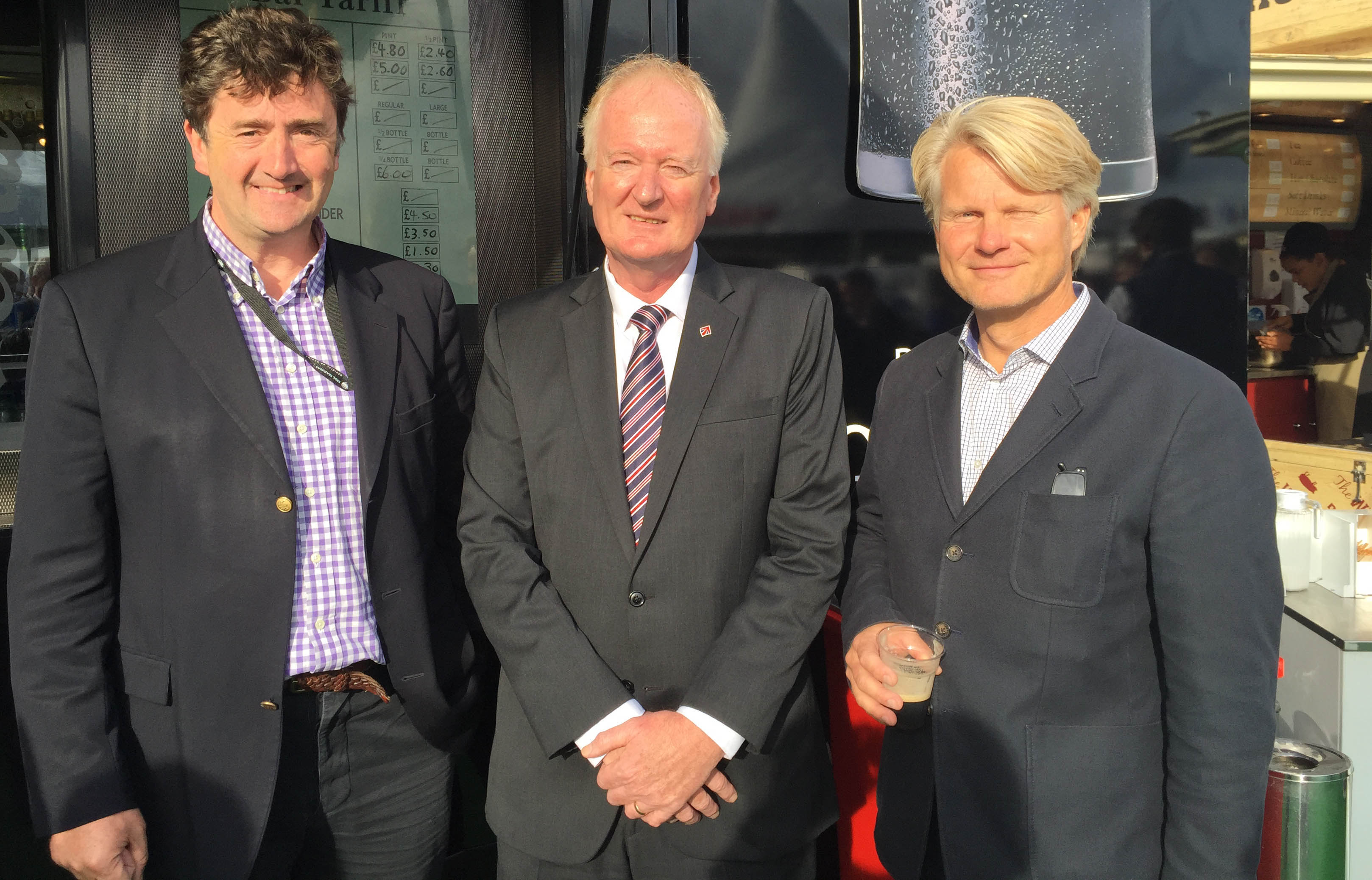
Pride of place for Irish stands at Southampton went to the impressive MGM Boats brokerage stand excellently located at the top of the ramp to the show marina. It was an impressive display of boats using the latest digital screens to display boats specs and prices.
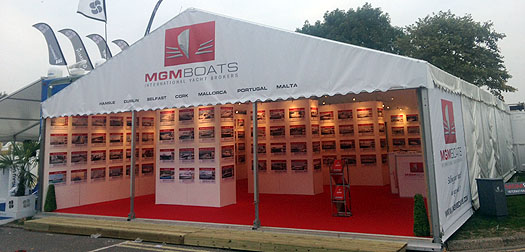
The MGM Brokerage stand - the venue for boat sales as well as the Ireland v Canada Rugby match last Saturday
The stand had over €60m of boat stock on display and the full MGM boats crew headed by Martin and Gerry Salmon were kept busy with 'quality enquiries' for their used sail and power range. The Salmon brothers were joined by John O'Kane, Ross O'Leary, Alan Barton and John McDonald and the company's presence was noted on Sunseeker, Galeon, Aquador, Lagoon, Jeanneau and Prestige stands.
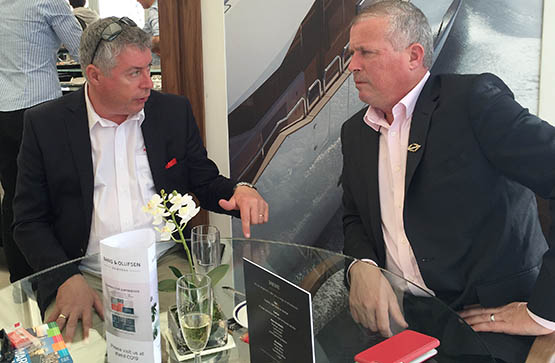
Martin (left) and Gerry Salmon discuss new boat deals at the Sunseeker stand
The Show saw 23 boats make their world debut and over 330 of the world's leading sailboats and high-performance powerboats on the water.
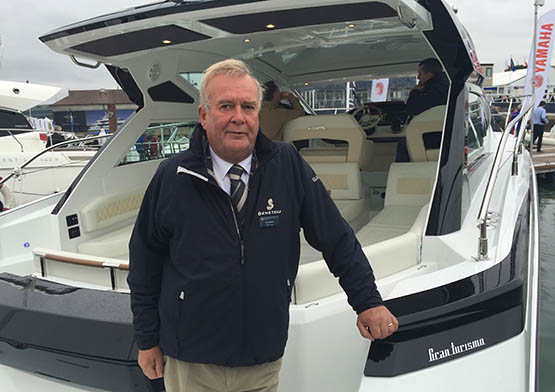
Alan Corr from BJ Marine in Greystones in County Wicklow was on Beneteau's new GT 40 from Beneteau
Strong sales have been reported throughout the duration of the Show, with many companies reporting an increase on last year’s figures including multi-million pound deals. Some serious marine business has been conducted with contracts between the marine divisions of companies such as Rolls-Royce and Sunseeker International being signed.
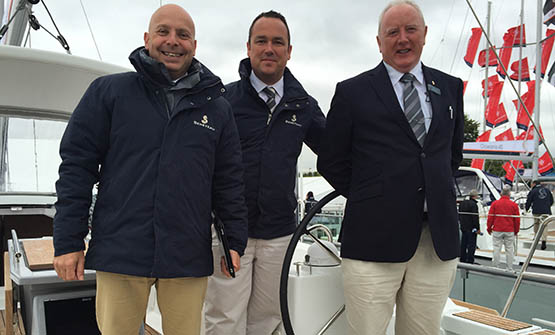
Mike Caplan (left), James Kirwan (centre) and Bernard Gallagher from BJ Marine on a new Oceanis 48 (show price £223,038) that will be coming to Dublin next season
'We have been delighted with our two weeks of boat shows in first Cannes and then Southampton. We secured deals for all offices, Greystones, Bangor, Pwllheli and Malta. Clients have been extremely interested in the price point of our new Beneteau GT 40, Fountaine Pajot's Saba 50 catamaran and Sea Ray's European built 355 Sundancer', James Kirwan of BJ Marine told Afloat.ie

Dufour's new 500 Grand Large was exhibited at Southampton by Cork Harbour's Hugh Mockler of Crosshaven Boatyard
Hugh Mockler of Crosshaven Boatyard was on board the Dufour 500 Grand Large. Mockler was imprerssed with the good turnout as well as a number of interested Irish parties in the new line–up. The Dufour 382 Grand Large was also afloat at the show. Crosshaven Boatyard was tweeting from the show about a new concept boat called the with a lifting keel designed for sailing schools. The brand new Dufour Drakkar 24 (below) is designed by Umberto Felci and it was unveiled at the French Grand Pavois, Boat Show in La Rochelle next week.
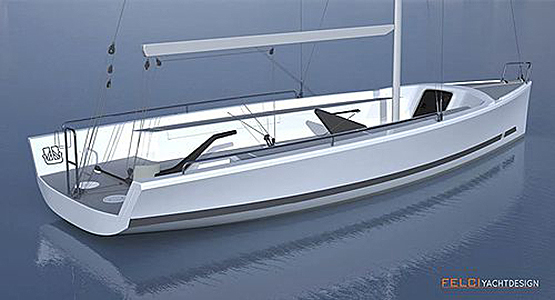
Debbie Weldon and Dick Fanning from Howth were onboard both of X Yachts Xc 38 and Xc 45 models. Fanning says yhe Xc 38 is the model that offers superb performance in an easily handled package and is ideal for doublehanded sailing. This model was the second yacht in the Xcruising range to be named European Yacht of the Year in the Luxury Cruiser category, on its launch.
Ronan Beirne of Leinster Boats of Dun Laoghaire said his Euro priced boat brokerage list was well received at the show. Several new enquiries were logged for vessel inspections in the coming weeks.
Bobby Nash of Kinsale was exhibiting his range of 3D Nautical charts displaying a selection from the British Isles, the Mediterranean and the Pacific. County Antrim based Red Bay Boats were also displaying their acclaimed range of Ribs. Both Gary Fyffe and Tom McLaughlin from the Cushendall firm were in attendance at the show.

Howth's Debbie Weldon (above) on the Danish built Xc38 and Dick Fanning (below) on the Xc45 from X–Yachts
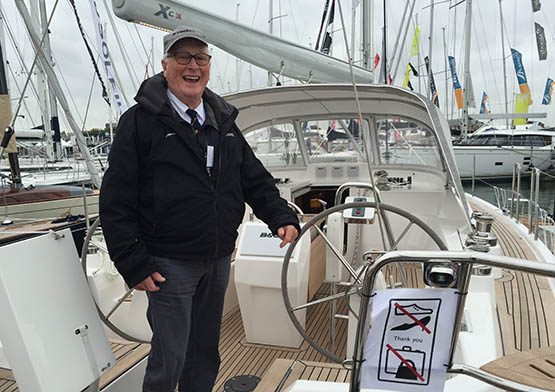
A number of key Irish ports and marinas were also promoting their wares. Aoife McHale was on hand at the Visit Derry stand continuing the promotion of Northern Ireland's maritime assets on Lough Foyle. McHale explained the city is also gearing up to welcoming the return of the Clipper Round the world race next year to the Malin coast.
Irish Sea interests were promoted by British Marine Wales where Ireland is seen as a key market.
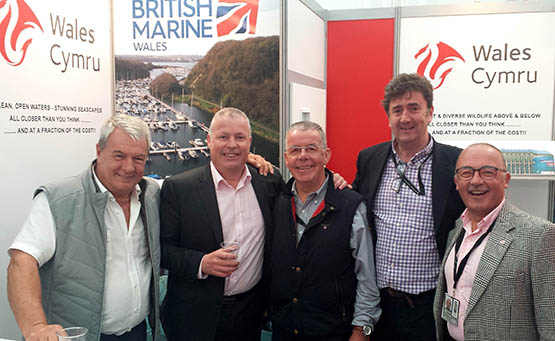
David Reed of Visit Wales, Gerry Salmon of MGM Boats, Alan Morgan of British Marine Wales, David O'Brien of the Irish Marine Federation and David Pougher of British Marine Wales
Irish Marine Federation Welcomes Changes to Foreshore Act
#foreshore – The Irish Marine Federation (IMF) has given a cautious welcome to much heralded changes to the foreshore bill that is designed to streamline the development consent process.
The government has published its Legislation Programme for Spring/Summer 2015 and the Maritime Area and Foreshore (Amendment) Bill is among a list of key Bills of interest which currently before the Houses of the Oireachtas.
The Bill will streamline the development consent process for the foreshore, including the integration of certain parts of the foreshore consent process (under the Foreshore Act 1933) with the existing on-land planning system.
The IMF, the national federation of the marine leisure industry in Ireland, has long held out that the failure to manage Ireland's natural resources "in a consistent or coherent manner" has led to serious setbacks in the support of marine tourism on the island.
The IMF has long argued the State must develop a clear and simplified pathway for the licensing of offshore and foreshore activity - in marina development, aquaculture, and energy exploitation. Currently, there is no timeframe for the granting of permissions leaving many developers facing a lifetime of unneccesary bureaucractic hurdles that stymies development, according to one marina developer.
In 2002, there was an attempt to address this when the Marine Institute published 'A Development Strategy for Marine Leisure Infrastructure'. Shortly afterwards, however, the responsibility for marine tourism research was transferred from the institute to the then Department of Arts, Sport and Tourism. It would appear that during this move, a disagreement over how this new responsibility for marine infrastructure was to be resourced led to its not being resourced at all.
In 2007, the Marine Institute followed up with another report - the Marine Tourism and Leisure Development Strategy 2007-2013 - which valued the water-based tourism and leisure sector at €630m and anticipated it would grow to €1bn by 2013.
That report identified a failure to manage Ireland's natural resources "in a consistent or coherent manner" in support of marine tourism. That report, and and its recommendations, was left to gather dust alongside its 2002 predecessor.
So it is something that the Government's new marine plan, 'Harvesting our Ocean Wealth' aims to develop a national maritime spatial plan, and recognises the need to engage with experts and stakeholders. But it is imperative that government does not overlook the various barriers and pressures that exist in our various sea areas.
Above all, the key to unlocking Ireland's marine potential, according to the Irish Marine Federation is to complete the necklace of marinas around our coast - marinas which can provide a lifeline for struggling coastal communities with the sort of jobs that cannot be shipped abroad.
Ireland has a chronically underdeveloped marina system. The single marina in La Rochelle, France, for example, has the same capacity as our entire island. There are more berths in North Wales alone than there are in all of Ireland.
Marinas create small hubs of marine enterprise, supplying services to cater for the boat owners gathered there or just visiting, and bringing massive spin-off benefits for the neighbouring coastal communities. Studies show that for every €10 spent by a yachtsman in a marina, €100 is spent in the local town in shops, pubs and restaurants.
A visiting overseas boat leaves €132 per night. A visiting Irish boat leaves considerably more at over €300 per night. The average spend of a boat owner in a marina berth is in excess of €8,000 per annum. Most of this stays in the local community. One full time job is supported by every 3.7 marina berths according to Federation reports.
#irishmarinefed – The Irish Marine Federation (IMF) meets in Dublin tomorrow to address priorities for the marine leisure industry after what has been a torrid time for marine trades in Ireland.
In a notice to members, Federation Chairman David O'Brien says 'like all small businesses, the IMF is building anew after recession'.
In a cautious note of optimism, O'Brien adds 'Although it still remains to be seen if we really have 'turned a corner', as our politicians like to tell us, nothing can stay dormant indefinitely.
The IMF, who organises the National Boat Show, expects new opportunities to arise as the economy improves and consumer confidence grows.
O'Brien explains that the IMF was only able to keep afloat in recession by slashing costs and running almost entirely by its volunteer committee. 'We may be a long way from the dizzy heights of the IMF 2006 Boat Show at the RDS but equally we're a long way from 1984 when VAT was 35%, the top rate of income tax 65% and mortgage rates hit 16%. Even then we managed to run a show...!'
In whatever form the next wave of activity comes, the IMF says it is ready and waiting to embark on a 'new chapter' for the industry. The IMF is keen to take on board views and suggestions and is also on a recruitment drive for new members.
The IMF agm takes place tomorrow at the National Yacht Club in Dun Laoghaire followed by a meeting of its Board who will focus on identifying IMF priorities for 2015 and 2016.
The new IMF website is operational at www.irishmarinefederation.com and the IMF is also on twitter @irishmarinefed
Marine Federation Meet to Discuss Credit Squeeze, Boat Registration
#irishmarinefederation – Today's Irish Marine Federation (IMF) agm at the Maldron Hotel, Portlaoise will hear that bank lending or the lack of it, continues to be a problem for boat sales.
It's just one of a number of key issues to be addressed by members at the annual gathering of chandlers, brokers, marina operators and boat hire companies.
'A continuing squeeze on credit to even AAA customers is having a detrimental effect on the boating industry' according to industry spokesperson Steve Conlon.
It's the biggest problem facing an industry that has contracted sharply in recession. Neverthetheless a core group of long established companies are riding out the economic storms and flying the flag for marine leisure business interests.
Also up for discussion at 2pm today are plans by the Department of Transport Tourism and Sport to address the issue of boat registration this year.
Currently recreational boats in Ireland are regulated in different ways depending on their size and what they are used for.
The IMF first raised the issue of registration with the then Minister, Dermot Ahern in 2002 and has made regular submissions to the Department since.
The IMF has also met with the Department's IT consultants who worked on an online registration system.
Lough Ree Water Level Lowering Would 'Disrupt Navigation' – Irish Marine Federation
#loughree – Any threat to the water levels on Lough Ree would mean disruption to the navigation in a number of places say the Irish Marine Federation (IMF) in its latest newsletter in response to farming demands for lower water levels to prevent flooding.
The Irish Farmers Association (IFA) has sought water level reduction on Lough Ree by 600mm the Athlone Callows region say the IMF but such a move would make the inner lakes no longer navigable.
The Farming body is also demanding a single authority rather than shared responsibility of ESB and Waterways Ireland be put in place to decide on when the levels should be reduced.
According to the IMF over the past 50 years a number of detailed studies have been produced by hydrologists and they have all come to the same conclusion that the Shannon flooding is not a manageable occurrence rather it is due entirely to the nature of the river.
The IMF claim say water level lowering would also cause disruption in the navigation to the south of Athlone.
The IMF has prepared a paper on the economic consequences of this action and plan to meet with the Minister responsible, Mr. Brian Hayes T.D. together with the Inland Waterways Association of Ireland.
Irish Boat Sales, Chandlery & Boat Hire Badly Hit by Recession
#marine – Although there has been a small but steady recovery the Irish Marine Federation (IMF) says in its latest bulletin to members, a reliable barometer of boating actiivty, the Irish boating trade is still a long way from getting back to anything that resembles a normal level of business.
'Our major dealers are relying on business generated from overseas clients, however, there has been some business done with Irish clients. Whilst consumer confidence remains low this trend will continue, says industry spokesman Steve Conlon.
The IMF's original estimate of quarter four of 2013 as marking the beginning of a consumer recovery now seems to be slipping further back.
Chandlery
Chandlery companies report a flat season with some exceptions in demand largely driven by the odd occasion of better weather or special events. The sector in common with others in the retail sector report low growth or at best flat with a halt to the downward trend of previous years.
It is expected the rise in the cost of Sterling will help counter the increase in online selling from UK based mail order companies.
Marinas
Business trends at marinas across the country vary with Dublin based marinas being the worst affected in terms of a loss of regular annual contracts.
There is an estimate of a 28% loss in annual contracts on the east coast. Cork marinas continue to have few or any vacancies with the marinas further west suffering a decline of approx 12% according to the IMF.
In spite of the industry wide decline there has been growth in seasonal contract business for some marinas and some marinas also report strong visiting numbers.
The federation says 'It is too early to say as to whether overseas visitors are down overall this year but the Failte Ireland survey may give us an accurate national picture for the first time'.
Boat Hire
Irish Boat Rental Association (IBRA) members reported a better than expected start to the season with a tailing off in September. Overall the business remains flat although preseason bookings were up slightly. The bad summer can be blamed for the slow up take from the domestic market, the Federation says.






























